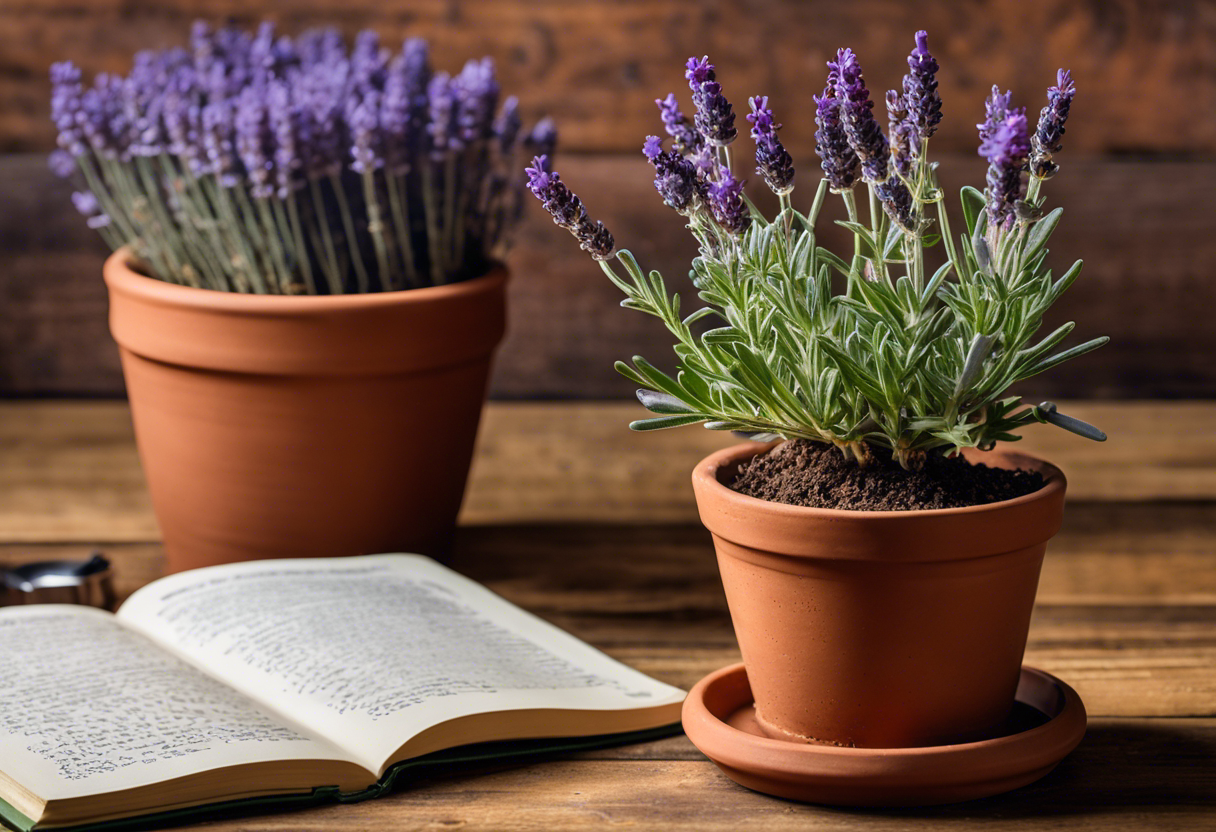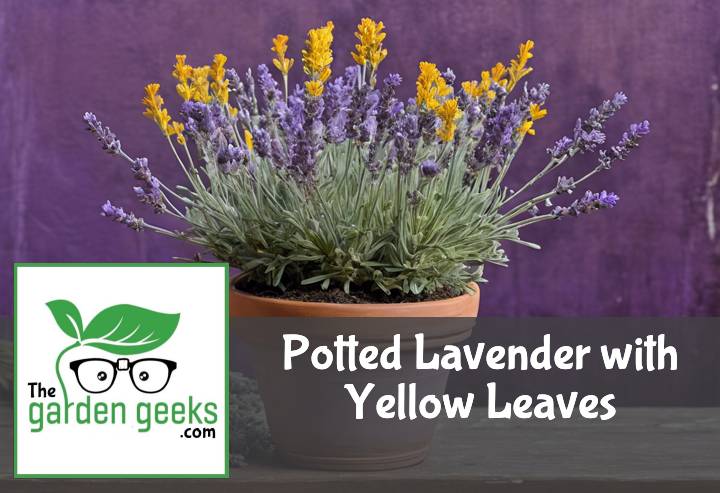Ever found yourself staring at your Potted Lavender with Yellow Leaves, scratching your head in confusion? Well, you’re not alone. I’ve been there too, wondering how my green thumb turned yellow overnight!
But don’t fret! It’s not as cryptic as it seems. With a little sleuthing and some TLC, your lavender can bounce back to its purple glory in no time. So buckle up, folks; we’re about to embark on a botanical mystery tour. Keep reading about ‘Potted Lavender with Yellow Leaves? (5 Causes and Solutions)’.
Key Takeaways
- Yellow leaves on potted lavender can be caused by overwatering, poor drainage, nutrient deficiency, insufficient light, or disease.
- Overwatering can be resolved by reducing watering frequency and ensuring the pot has good drainage.
- Nutrient deficiency can be corrected with a balanced fertilizer.
- If the plant is not getting enough light, move it to a sunnier location.
- Disease may require treatment with fungicides or insecticides. Always isolate diseased plants to prevent spread.

What Causes Yellow Leaves in Potted Lavender?
If you’re noticing your Potted Lavender with Yellow Leaves, don’t panic! It’s a common issue, often linked to watering habits, sunlight exposure, nutrient levels, or pesky pests and diseases. Let’s dive into these causes and how to fix them.
Insufficient Watering
Under-watering can leave your lavender parched and stressed, leading to yellow leaves. Signs of an under-watered lavender include drooping leaves and dry soil. If your plant seems thirsty, it’s time to adjust your watering techniques.
Remember, lavenders are Mediterranean plants that love a good drink but hate soggy feet. Soak the soil thoroughly when watering and let it dry out before the next session. This way, you’ll keep your lavender happy without drowning it.
Overwatering
On the flip side, overwatering can cause as much harm as under-watering. Too much water leads to root rot – a surefire ticket to yellow leaves. Telltale signs of an overwatered lavender include wilting despite wet soil and blackened roots.
The key is balance. Establish a proper watering schedule based on your plant’s needs and environmental conditions. Remember: when in doubt, it’s better to underwater than overwater!
Lack of Sunlight
Lavenders love basking in the sun! Without enough light, they start throwing a fit – aka turning yellow. If your lavender isn’t getting enough rays indoors or outdoors, you might see some yellow leaves from low light.
To keep your lavender healthy and vibrant, ensure it gets at least 6 hours of sunlight daily. If indoor lighting is insufficient, consider using grow lights for that extra boost.
Nutrient Deficiency
Just like us humans need our vitamins and minerals for optimal health, plants have their own nutrient needs too! A deficiency in essential nutrients can lead to yellow leaves in your lavender.
Lavenders particularly need nitrogen, phosphorus, and potassium. If these are lacking, consider using a balanced fertilizer to replenish the soil. Remember: moderation is key! Over-fertilizing can cause more harm than good.
Disease or Pest Infestation
Finally, diseases and pests can wreak havoc on your lavender plant, leading to yellow leaves. Common culprits include fungal diseases like root rot and pests like aphids or whiteflies.
If you suspect a disease or pest infestation, it’s best to consult with a plant expert or use organic pesticides. Regularly inspecting your plants for signs of disease and maintaining good Potted Lavender Care practices can prevent these issues from cropping up in the first place!
How to Identify the Cause of Yellow Leaves in Potted Lavender?

Identifying the cause of yellow leaves in potted lavender is crucial for effective potted lavender care. It could be due to underwatering, overwatering, sunlight exposure, nutrient deficiency or disease and pest infestation. Each cause has unique signs that help in identifying plant issues.
Signs of Underwatering and Overwatering
Underwatered lavenders show symptoms like wilting and dry soil. The leaves turn yellow because they’re thirsty! On the other hand, overwatered lavenders have waterlogged soil and droopy leaves. Too much water can drown your plant, causing yellow leaves on lavender.
Assessing Sunlight Exposure
Sunlight plays a big role in your lavender’s health. If your plant’s not getting enough light, it might start showing yellow leaves on lavender. But too much sun can also burn the leaves! Check where your pot is placed and assess if it’s getting the right amount of light.
Identifying Nutrient Deficiency Symptoms
Nutrient deficiencies can lead to yellow leaves too. If your lavender lacks essential nutrients like nitrogen or iron, its leaves may turn yellow. Look out for pale green or yellowish leaves as signs of nutrient deficiency.
Detecting Disease or Pest Infestation
Disease or pest infestations are another common cause of yellow leaves. Fungi like root rot can make your plant sick while pests like aphids suck life out of it! Keep an eye out for any unusual spots or bugs on your lavender.

Solutions for Each Cause of Yellow Leaves in Potted Lavender
When your Potted Lavender with Yellow Leaves starts to look a bit sad, don’t fret! There are solutions to bring it back to its vibrant self. Let’s dive into the nitty-gritty of Potted Lavender Care and Yellow Leaves Solutions.
Correct Watering Techniques for Potted Lavender
The key to a healthy lavender is proper watering. Overwatering or underwatering can lead to yellow leaves, so it’s crucial to strike a balance. The Lavender Watering Guide suggests watering when the top inch of soil feels dry. Remember, lavenders prefer being slightly thirsty than drowning in water. So, keep an eye on those Overwatering Effects on Lavender and Underwatering Symptoms in Lavender, folks!
Adjusting Sunlight Exposure for Potted Lavender
Sunlight: too much or too little can turn your lavender’s leaves yellow. It’s all about finding that sweet spot! The general rule is 6-8 hours of sunlight daily. But hey, if you notice signs of sunburn (yes, plants get sunburnt too), move your plant away from direct light. And remember, adjusting the Sunlight Requirements for Lavender can make a world of difference!
Supplementing Nutrients for Potted Lavender
Just like us humans, lavenders need their vitamins too! A lack of nutrients can cause yellow leaves. So how about giving your potted lavender some TLC with suitable fertilizers or soil amendments? Keep an eye out for signs of Nutrient Deficiency in Plants, and remember that a well-fed lavender is a happy lavender!
Treating Diseases and Pest Infestations in Potted Lavender
Last but not least, diseases and pests could be turning your lavender’s leaves yellow. Common culprits include fungal diseases and aphids. But don’t worry, there are plenty of Common Plant Diseases and Treatments available. And when it comes to pests, a little bit of neem oil can go a long way in keeping them at bay! So, arm yourself with these Pest Control Tips for Indoor Plants, and you’ll be well on your way to restoring your lavender’s health.
Preventive Measures to Avoid Yellow Leaves in Potted Lavender
Prevention is better than cure, right? The same applies to your potted lavender with yellow leaves. By taking some preventive measures, you can maintain a healthy plant and avoid those pesky yellow leaves.
Regular Monitoring and Care Routine
Regular care for potted lavender is like a health check-up for humans. It helps you spot any issues early on and nip them in the bud. Monitoring plant health regularly can help prevent yellow leaves through monitoring.
Routine plant check-ups are essential to keep your lavender happy and healthy. Remember, consistency is key here! The importance of regular plant care cannot be overstated when it comes to preventing plant diseases.
Choosing the Right Soil and Pot
The soil you choose for your lavender can make or break its health. Selecting soil for lavenders that drains well can help prevent those dreaded yellow leaves.
The pot also plays a vital role in the health of your potted lavender. A right pot for potted lavender should have adequate drainage holes to prevent waterlogging, which could lead to leaf discoloration.
Proper Positioning and Spacing
Where you place your potted lavender matters a lot! Correct positioning for potted lavender ensures it gets enough sunlight but not too much heat.
Spacing between plants also contributes significantly to their overall health. Overcrowding can lead to poor air circulation, increasing the risk of diseases that cause leaf yellowing.
Remember folks, prevention is always better than cure! So take these preventive care tips seriously if you want a healthy potted lavender free from yellow leaves!

To Wrap Up
So, we’ve journeyed through the land of Potted Lavender with Yellow Leaves, and what a ride it’s been! Like solving a juicy mystery novel, we’ve uncovered the five culprits behind our lavender’s yellowing leaves.
Remember folks, caring for your lavender is like being a good detective. Stay observant, keep your watering can in check and always have that soil pH tester handy. Happy gardening!


